Low Smoke Zero Halogen (LSZH) Power Cords
What is Low Smoke Zero Halogen (LSZH) cable and what is different about the material composition.
Standard power cable jackets are made from a PVC compound that contains Chorine (part of the Halogen Group) which when burned will release a toxic gas that can cause serious damage to humans and electrical equipment.
Low smoke zero halogen cable uses.
These special cables are utilized where smoke/toxic fume emissions due to fire can create a potential threat to life and equipment. Low Smoke Zero Halogen cabling is usually used in regulated industries like government jobs. New data centers sometimes choose to use LSZH cabling to help protect data center facilities from harmful smoke in case of fire. Because Data Centers use so many ventilation and cooling systems to dissipate the heat, even a small amount of smoke in a small area can quickly be distributed throughout the entire building.

Black LSZH Cordage IEC320 C14 to IEC320 C15 10A 250V
Specifications
Countries of Certification The below list may not be a complete list of the applicable countries for this product. Contact us if you are inquiring about a specific country.
Select Length
Need assistance? Give us a call, 860-763-2100

C14 to C5 2.5A 250V Power Cord with LSZH cordage - BLACK
Specifications
Countries of Certification The below list may not be a complete list of the applicable countries for this product. Contact us if you are inquiring about a specific country.
Select Length
Need assistance? Give us a call, 860-763-2100
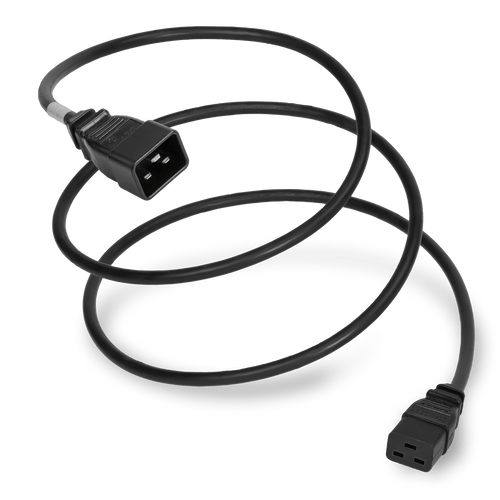
Black LSZH Cordage IEC320 C20 to IEC320 C19 15A 250V
Specifications
Countries of Certification The below list may not be a complete list of the applicable countries for this product. Contact us if you are inquiring about a specific country.
Select Length
Need assistance? Give us a call, 860-763-2100
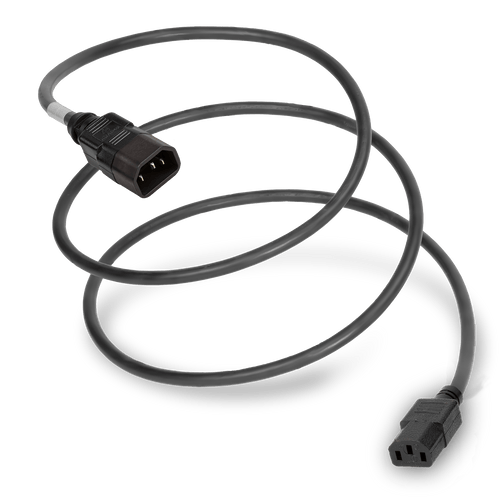
Black LSZH Cordage IEC320 C14 to IEC320 C13 10A 250V
Specifications
Countries of Certification The below list may not be a complete list of the applicable countries for this product. Contact us if you are inquiring about a specific country.
Select Length
Need assistance? Give us a call, 860-763-2100
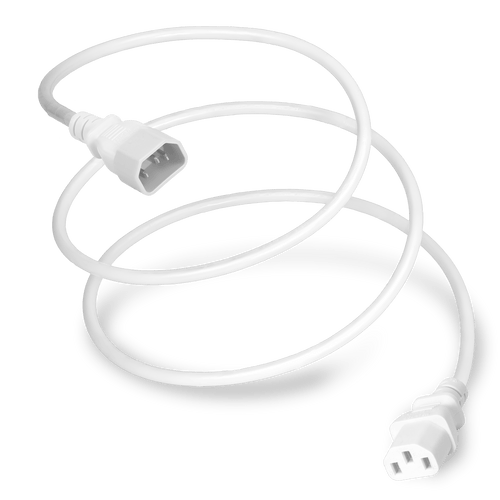
White LSZH Cordage IEC320 C14 to IEC320 C13 10A 250V
Specifications
Countries of Certification The below list may not be a complete list of the applicable countries for this product. Contact us if you are inquiring about a specific country.
Select Length
Need assistance? Give us a call, 860-763-2100
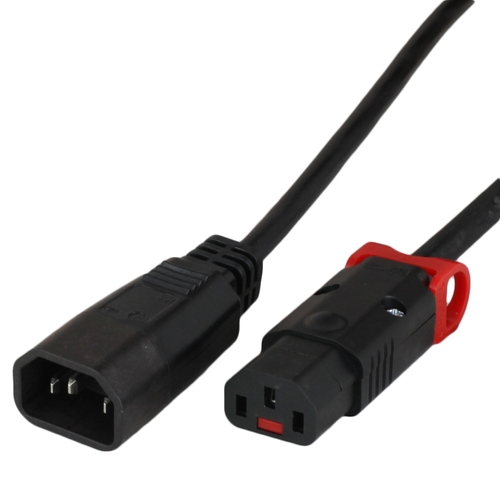
Black LSZH Cordage IEC320 C14 to IEC320 C13 IEC Lock 10A 250V
Specifications
Countries of Certification The below list may not be a complete list of the applicable countries for this product. Contact us if you are inquiring about a specific country.
Select Length
Need assistance? Give us a call, 860-763-2100

Black LSZH Cordage IEC320 C14 to IEC320 C5 10A 250V
Specifications
Countries of Certification The below list may not be a complete list of the applicable countries for this product. Contact us if you are inquiring about a specific country.
Select Length
Need assistance? Give us a call, 860-763-2100

Black LSZH Power Whip Open 2" ROJ & 1/4" Strip to IEC320 C13 10A 250V
Specifications
Countries of Certification The below list may not be a complete list of the applicable countries for this product. Contact us if you are inquiring about a specific country.
Select Length
Need assistance? Give us a call, 860-763-2100
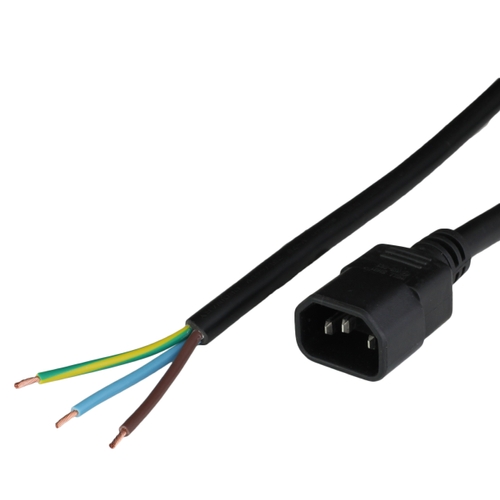
Black LSZH Power Whip IEC320 C14 to Open 2" ROJ & 1/4" Strip 10A 250V
Specifications
Countries of Certification The below list may not be a complete list of the applicable countries for this product. Contact us if you are inquiring about a specific country.
Select Length
Need assistance? Give us a call, 860-763-2100
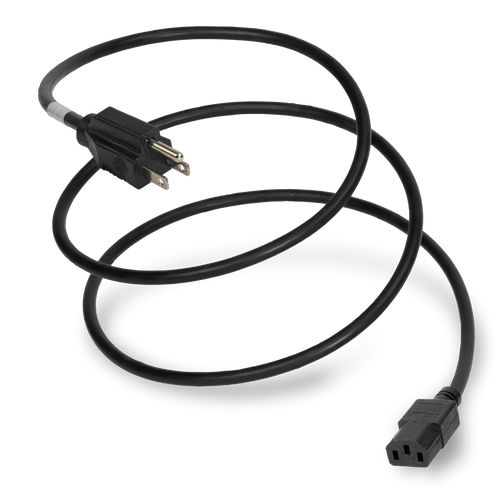
Black LSZH Cordage NEMA 5-15P to IEC320 C13 15A 125V
Specifications
Countries of Certification The below list may not be a complete list of the applicable countries for this product. Contact us if you are inquiring about a specific country.
Select Length
Need assistance? Give us a call, 860-763-2100
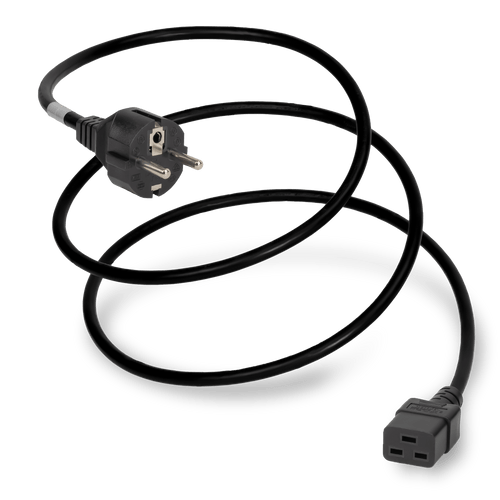
Black LSZH Cordage CEE7/7 Schuko to IEC320 C19 16A 250V
Specifications
Countries of Certification The below list may not be a complete list of the applicable countries for this product. Contact us if you are inquiring about a specific country.
Select Length
Need assistance? Give us a call, 860-763-2100
Filters
| Image | Part/Description | Specifications | Availability | Pricing | Qty | |
|---|---|---|---|---|---|---|

|
FC19-67144
12FT Black LSZH Cordage CEE7/7 Schuko to IEC320 C19 16A 250V |
Plug (Male)
European Schuko CEE7/7 - Straight
Connector (Female)
IEC 60320 C19
Length
12 Feet
Color
Black
Current (Amps)
16 Amps
Voltage (Volts)
250 volts
Cordage
1.5mm2 -3c LSZH
Certifications
RoHS
|
|
|||
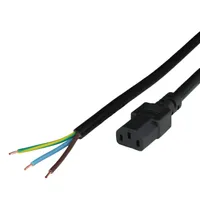
|
ZH10-0013-036-BLK
3FT Black LSZH Power Whip Open 2" ROJ & 1/4" Strip to IEC320 C13 10A 250V |
Connector (Female)
IEC 60320 C13
Length
3 Feet
Color
Black
Current (Amps)
10 Amps
Voltage (Volts)
250 volts
Cordage
1.0mm2 -3c LSZH
Certifications
RoHS
Open End
2" ROJ 1/4" Strip ICC
|
|
|||

|
ZH10-0013-072-BLK
6FT Black LSZH Power Whip Open 2" ROJ & 1/4" Strip to IEC320 C13 10A 250V |
Connector (Female)
IEC 60320 C13
Length
6 Feet
Color
Black
Current (Amps)
10 Amps
Voltage (Volts)
250 volts
Cordage
1.0mm2 -3c LSZH
Certifications
RoHS
Open End
2" ROJ 1/4" Strip ICC
|
|
|||

|
ZH10-0013-084-BLK
7FT Black LSZH Power Whip Open 2" ROJ & 1/4" Strip to IEC320 C13 10A 250V |
Connector (Female)
IEC 60320 C13
Length
7 Feet
Color
Black
Current (Amps)
10 Amps
Voltage (Volts)
250 volts
Cordage
1.0mm2 -3c LSZH
Certifications
RoHS
Open End
2" ROJ 1/4" Strip ICC
|
|
|||

|
ZH10-0013-144-BLK
12FT Black LSZH Power Whip Open 2" ROJ & 1/4" Strip to IEC320 C13 10A 250V |
Connector (Female)
IEC 60320 C13
Length
12 Feet
Color
Black
Current (Amps)
10 Amps
Voltage (Volts)
250 volts
Cordage
1.0mm2 -3c LSZH
Certifications
RoHS
Open End
2" ROJ 1/4" Strip ICC
|
|
|||

|
ZH10-1400-096-BLK
8FT Black LSZH Power Whip IEC320 C14 to Open 2" ROJ & 1/4" Strip 10A 250V |
Plug (Male)
IEC 60320 C14
Length
8 Feet
Current (Amps)
10 Amps
Voltage (Volts)
250 volts
Cordage
1.0mm2 -3c LSZH
Open End
2" ROJ 1/4" Strip ICC
|
|
|||
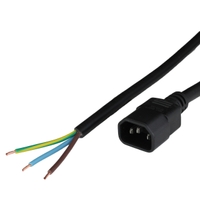
|
ZH10-1400-108-BLK
9FT Black LSZH Power Whip IEC320 C14 to Open 2" ROJ & 1/4" Strip 10A 250V |
Plug (Male)
IEC 60320 C14
Length
9 Feet
Current (Amps)
10 Amps
Voltage (Volts)
250 volts
Cordage
1.0mm2 -3c LSZH
Open End
2" ROJ 1/4" Strip ICC
|
|
|||

|
ZH10-1400-192-BLK
16FT Black LSZH Power Whip IEC320 C14 to Open 2" ROJ & 1/4" Strip 10A 250V |
Plug (Male)
IEC 60320 C14
Length
16 Feet
Current (Amps)
10 Amps
Voltage (Volts)
250 volts
Cordage
1.0mm2 -3c LSZH
Open End
2" ROJ 1/4" Strip ICC
|
|
|||

|
ZH10-1405-079-BLK
2M Black LSZH Cordage IEC320 C14 to IEC320 C5 10A 250V |
Plug (Male)
IEC 60320 C14
Connector (Female)
IEC 60320 C5
Length
2.0 meters
Color
Black
Current (Amps)
2.5 Amps
Voltage (Volts)
250 volts
Cordage
1.0mm2 -3c LSZH
Certifications
RoHS
|
|
|||

|
ZH10-1413-024-BLK
2FT Black LSZH Cordage IEC320 C14 to IEC320 C13 10A 250V |
Plug (Male)
IEC 60320 C14
Connector (Female)
IEC 60320 C13
Length
2 Feet
Color
Black
Current (Amps)
10 Amps
Voltage (Volts)
250 volts
Cordage
1.0mm2 -3c LSZH
|
|
|||

|
ZH10-1413-036-BLK
3FT Black LSZH Cordage IEC320 C14 to IEC320 C13 10A 250V |
Plug (Male)
IEC 60320 C14
Connector (Female)
IEC 60320 C13
Length
3 Feet
Color
Black
Current (Amps)
10 Amps
Voltage (Volts)
250 volts
Cordage
1.0mm2 -3c LSZH
|
|
|||

|
ZH10-1413-048-BLK
4FT Black LSZH Cordage IEC320 C14 to IEC320 C13 10A 250V |
Plug (Male)
IEC 60320 C14
Connector (Female)
IEC 60320 C13
Length
4 Feet
Color
Black
Current (Amps)
10 Amps
Voltage (Volts)
250 volts
Cordage
1.0mm2 -3c LSZH
|
|
|||

|
ZH10-1413-054-BLK
4.5FT Black LSZH Cordage IEC320 C14 to IEC320 C13 10A 250V |
Plug (Male)
IEC 60320 C14
Connector (Female)
IEC 60320 C13
Length
4.5 Feet
Color
Black
Current (Amps)
10 Amps
Voltage (Volts)
250 volts
Cordage
1.0mm2 -3c LSZH
|
|
|||

|
ZH10-1413-060-BLK
5FT Black LSZH Cordage IEC320 C14 to IEC320 C13 10A 250V |
Plug (Male)
IEC 60320 C14
Connector (Female)
IEC 60320 C13
Length
5 Feet
Color
Black
Current (Amps)
10 Amps
Voltage (Volts)
250 volts
Cordage
1.0mm2 -3c LSZH
|
|
|||

|
ZH10-1413-072-BLK
6FT Black LSZH Cordage IEC320 C14 to IEC320 C13 10A 250V |
Plug (Male)
IEC 60320 C14
Connector (Female)
IEC 60320 C13
Length
6 Feet
Color
Black
Current (Amps)
10 Amps
Voltage (Volts)
250 volts
Cordage
1.0mm2 -3c LSZH
|
|
|||

|
ZH10-1413-079-BLK
2M Black LSZH Cordage IEC320 C14 to IEC320 C13 10A 250V |
Plug (Male)
IEC 60320 C14
Connector (Female)
IEC 60320 C13
Length
2.0 meters
Color
Black
Current (Amps)
10 Amps
Voltage (Volts)
250 volts
Cordage
1.0mm2 -3c LSZH
|
|
|||

|
ZH10-1413-084-BLK
7FT Black LSZH Cordage IEC320 C14 to IEC320 C13 10A 250V |
Plug (Male)
IEC 60320 C14
Connector (Female)
IEC 60320 C13
Length
7 Feet
Color
Black
Current (Amps)
10 Amps
Voltage (Volts)
250 volts
Cordage
1.0mm2 -3c LSZH
|
|
|||

|
ZH10-1413-098-BLK
8FT Black LSZH Cordage IEC320 C14 to IEC320 C13 10A 250V |
Plug (Male)
IEC 60320 C14
Connector (Female)
IEC 60320 C13
Length
98 Foot
Color
Black
Current (Amps)
10 Amps
Voltage (Volts)
250 volts
Cordage
1.0mm2 -3c LSZH
|
|
|||

|
ZH10-1413-108-BLK
9FT Black LSZH Cordage IEC320 C14 to IEC320 C13 10A 250V |
Plug (Male)
IEC 60320 C14
Connector (Female)
IEC 60320 C13
Length
9 Feet
Color
Black
Current (Amps)
10 Amps
Voltage (Volts)
250 volts
Cordage
1.0mm2 -3c LSZH
|
|
|||

|
ZH10-1413-120-BLK
10FT Black LSZH Cordage IEC320 C14 to IEC320 C13 10A 250V |
Plug (Male)
IEC 60320 C14
Connector (Female)
IEC 60320 C13
Length
10 Feet
Color
Black
Current (Amps)
10 Amps
Voltage (Volts)
250 volts
Cordage
1.0mm2 -3c LSZH
|
|
|||

|
ZH10-1413-157-BLK
4M Black LSZH Cordage IEC320 C14 to IEC320 C13 10A 250V |
Plug (Male)
IEC 60320 C14
Connector (Female)
IEC 60320 C13
Length
4.0 meters
Color
Black
Current (Amps)
10 Amps
Voltage (Volts)
250 volts
Cordage
1.0mm2 -3c LSZH
|
|
|||

|
ZH10-1413-180-BLK
15FT Black LSZH Cordage IEC320 C14 to IEC320 C13 10A 250V |
Plug (Male)
IEC 60320 C14
Connector (Female)
IEC 60320 C13
Length
15 Feet
Color
Black
Current (Amps)
10 Amps
Voltage (Volts)
250 volts
Cordage
1.0mm2 -3c LSZH
|
|
|||

|
ZH10-1413-196-BLK
5M Black LSZH Cordage IEC320 C14 to IEC320 C13 10A 250V |
Plug (Male)
IEC 60320 C14
Connector (Female)
IEC 60320 C13
Length
5.0 meters
Color
Black
Current (Amps)
10 Amps
Voltage (Volts)
250 volts
Cordage
1.0mm2 -3c LSZH
|
|
|||
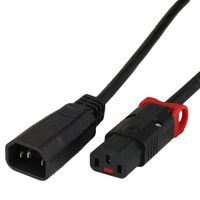
|
ZH10-1413K-144-BLK.ASY
12FT Black LSZH Cordage IEC320 C14 to IEC320 C13 IEC Lock 10A 250V |
Plug (Male)
IEC 60320 C14
Connector (Female)
IEC 60320 C13 Locking (IEC-Lock)
Length
12 Feet
Color
Black
Current (Amps)
10 Amps
Voltage (Volts)
250 volts
Cordage
1.0mm2 -3c LSZH
Certifications
RoHS
|
|
|||

|
ZH10-1413K-180-BLK.ASY
15FT Black LSZH Cordage IEC320 C14 to IEC320 C13 IEC Lock 10A 250V |
Plug (Male)
IEC 60320 C14
Connector (Female)
IEC 60320 C13 Locking (IEC-Lock)
Length
15 Feet
Color
Black
Current (Amps)
10 Amps
Voltage (Volts)
250 volts
Cordage
1.0mm2 -3c LSZH
Certifications
RoHS
|
|
|||
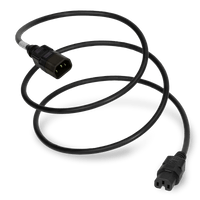
|
ZH10-1415-072-BLK
6FT Black LSZH Cordage IEC320 C14 to IEC320 C15 10A 250V |
Plug (Male)
IEC 60320 C14
Connector (Female)
IEC 60320 C15
Length
6 Feet
Color
Black
Current (Amps)
10 Amps
Voltage (Volts)
250 volts
Cordage
1.0mm2 -3c LSZH
Certifications
RoHS, REACH
|
|
|||

|
ZH10-1415-079-BLK
2M Black LSZH Cordage IEC320 C14 to IEC320 C15 10A 250V |
Plug (Male)
IEC 60320 C14
Connector (Female)
IEC 60320 C15
Length
2.0 meters
Color
Black
Current (Amps)
10 Amps
Voltage (Volts)
250 volts
Cordage
1.0mm2 -3c LSZH
Certifications
RoHS
REACH
|
|
|||

|
ZH10-1415-098-BLK
8FT Black LSZH Cordage IEC320 C14 to IEC320 C15 10A 250V |
Plug (Male)
IEC 60320 C14
Connector (Female)
IEC 60320 C15
Length
2.5 meters
Color
Black
Current (Amps)
10 Amps
Voltage (Volts)
250 volts
Cordage
1.0mm2 -3c LSZH
Certifications
RoHS
REACH
|
|
|||

|
ZH10-1415-120-BLK
10FT Black LSZH Cordage IEC320 C14 to IEC320 C15 10A 250V |
Plug (Male)
IEC 60320 C14
Connector (Female)
IEC 60320 C15
Length
10 Feet
Color
Black
Current (Amps)
10 Amps
Voltage (Volts)
250 volts
Cordage
1.0mm2 -3c LSZH
Certifications
RoHS
REACH
|
|
|||

|
ZH10-1415-180-BLK
15FT Black LSZH Cordage IEC320 C14 to IEC320 C15 10A 250V |
Plug (Male)
IEC 60320 C14
Connector (Female)
IEC 60320 C15
Length
15 Feet
Color
Black
Current (Amps)
10 Amps
Voltage (Volts)
250 volts
Cordage
1.0mm2 -3c LSZH
Certifications
RoHS, REACH
|
|
|||
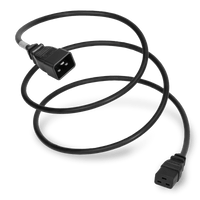
|
ZH15-2019-012-BLK
1FT Black LSZH Cordage IEC320 C20 to IEC320 C19 15A 250V |
Plug (Male)
IEC 60320 C20
Connector (Female)
IEC 60320 C19
Length
1 Foot
Color
Black
Current (Amps)
15 Amps
Voltage (Volts)
250 volts
Cordage
1.5mm2 -3c LSZH
Certifications
RoHS
|
|
|||

|
ZH15-2019-079-BLK
2M Black LSZH Cordage IEC320 C20 to IEC320 C19 15A 250V |
Plug (Male)
IEC 60320 C20
Connector (Female)
IEC 60320 C19
Length
2.0 meters
Color
Black
Current (Amps)
15 Amps
Voltage (Volts)
250 volts
Cordage
1.5mm2 -3c LSZH
Certifications
RoHS
|
|
|||

|
ZH15-2019-098-BLK
2.5M Black LSZH Cordage IEC320 C20 to IEC320 C19 15A 250V |
Plug (Male)
IEC 60320 C20
Connector (Female)
IEC 60320 C19
Length
8 Feet
Color
Black
Current (Amps)
15 Amps
Voltage (Volts)
250 volts
Cordage
1.5mm2 -3c LSZH
Certifications
RoHS
|
|
|||

|
ZH15-2019-108-BLK
9FT Black LSZH Cordage IEC320 C20 to IEC320 C19 15A 250V |
Plug (Male)
IEC 60320 C20
Connector (Female)
IEC 60320 C19
Length
9 Feet
Color
Black
Current (Amps)
15 Amps
Voltage (Volts)
250 volts
Cordage
1.5mm2 -3c LSZH
Certifications
RoHS
|
|
|||

|
ZH15-2019-120-BLK
10FT Black LSZH Cordage IEC320 C20 to IEC320 C19 15A 250V |
Plug (Male)
IEC 60320 C20
Connector (Female)
IEC 60320 C19
Length
10 Feet
Color
Black
Current (Amps)
15 Amps
Voltage (Volts)
250 volts
Cordage
1.5mm2 -3c LSZH
Certifications
RoHS
|
|
|||

|
ZH15-2019-157-BLK
4M Black LSZH Cordage IEC320 C20 to IEC320 C19 15A 250V |
Plug (Male)
IEC 60320 C20
Connector (Female)
IEC 60320 C19
Length
4.0 meters
Color
Black
Current (Amps)
15 Amps
Voltage (Volts)
250 volts
Cordage
1.5mm2 -3c LSZH
Certifications
RoHS
|
|
|||
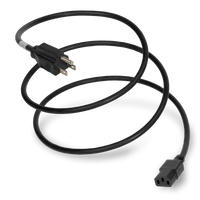
|
ZH15-51513-012-BLK
1FT Black LSZH Cordage NEMA 5-15P to IEC320 C13 15A 125V |
Plug (Male)
NEMA 5-15P
Connector (Female)
IEC 60320 C13
Length
1 Foot
Color
Black
Current (Amps)
13 Amps
Voltage (Volts)
125 volts
Cordage
1.5mm2 -3c LSZH
Certifications
RoHS
Diameter, Nominal O.D. (mm)
8
|
|
|||

|
ZH15-51513-024-BLK
2FT Black LSZH Cordage NEMA 5-15P to IEC320 C13 15A 125V |
Plug (Male)
NEMA 5-15P
Connector (Female)
IEC 60320 C13
Length
2 Feet
Color
Black
Current (Amps)
13 Amps
Voltage (Volts)
125 volts
Cordage
1.5mm2 -3c LSZH
Certifications
RoHS
Diameter, Nominal O.D. (mm)
8
|
|
|||

|
ZH15-51513-036-BLK
3FT Black LSZH Cordage NEMA 5-15P to IEC320 C13 15A 125V |
Plug (Male)
NEMA 5-15P
Connector (Female)
IEC 60320 C13
Length
3 Feet
Color
Black
Current (Amps)
13 Amps
Voltage (Volts)
125 volts
Cordage
1.5mm2 -3c LSZH
Certifications
RoHS
Diameter, Nominal O.D. (mm)
8
|
|
|||

|
ZH15-51513-048-BLK
4FT Black LSZH Cordage NEMA 5-15P to IEC320 C13 15A 125V |
Plug (Male)
NEMA 5-15P
Connector (Female)
IEC 60320 C13
Length
4 Feet
Color
Black
Current (Amps)
13 Amps
Voltage (Volts)
125 volts
Cordage
1.5mm2 -3c LSZH
Certifications
RoHS
Diameter, Nominal O.D. (mm)
8
|
|
|||

|
ZH15-51513-072-BLK
6FT Black LSZH Cordage NEMA 5-15P to IEC320 C13 15A 125V |
Plug (Male)
NEMA 5-15P
Connector (Female)
IEC 60320 C13
Length
6 Feet
Color
Black
Current (Amps)
13 Amps
Voltage (Volts)
125 volts
Cordage
1.5mm2 -3c LSZH
Certifications
RoHS
Diameter, Nominal O.D. (mm)
8
|
|
|||

|
ZH15-51513-079-BLK
2M Black LSZH Cordage NEMA 5-15P to IEC320 C13 15A 125V |
Plug (Male)
NEMA 5-15P
Connector (Female)
IEC 60320 C13
Length
2.0 meters
Color
Black
Current (Amps)
13 Amps
Voltage (Volts)
125 volts
Cordage
1.5mm2 -3c LSZH
Certifications
RoHS
Diameter, Nominal O.D. (mm)
8
|
|
|||

|
ZH15-51513-098-BLK
8FT Black LSZH Cordage NEMA 5-15P to IEC320 C13 13A 125V |
Plug (Male)
NEMA 5-15P
Connector (Female)
IEC 60320 C13
Length
98 Foot
Color
Black
Current (Amps)
13 Amps
Voltage (Volts)
125 volts
Cordage
1.5mm2 -3c LSZH
Certifications
RoHS
Diameter, Nominal O.D. (mm)
8
|
|
|||

|
ZH15-51513-108-BLK
9FT Black LSZH Cordage NEMA 5-15P to IEC320 C13 15A 125V |
Plug (Male)
NEMA 5-15P
Connector (Female)
IEC 60320 C13
Length
9 Feet
Color
Black
Current (Amps)
13 Amps
Voltage (Volts)
125 volts
Cordage
1.5mm2 -3c LSZH
Certifications
RoHS
Diameter, Nominal O.D. (mm)
8
|
|
|||

|
ZH15-51513-120-BLK
10FT Black LSZH Cordage NEMA 5-15P to IEC320 C13 15A 125V |
Plug (Male)
NEMA 5-15P
Connector (Female)
IEC 60320 C13
Length
10 Feet
Color
Black
Current (Amps)
13 Amps
Voltage (Volts)
125 volts
Cordage
1.5mm2 -3c LSZH
Certifications
RoHS
Diameter, Nominal O.D. (mm)
8
|
|
|||

|
ZH15-51513-300-BLK
25FT Black LSZH Cordage NEMA 5-15P to IEC320 C13 15A 125V |
Plug (Male)
NEMA 5-15P
Connector (Female)
IEC 60320 C13
Length
25 Feet
Color
Black
Current (Amps)
13 Amps
Voltage (Volts)
125 volts
Cordage
1.5mm2 -3c LSZH
Certifications
RoHS
Diameter, Nominal O.D. (mm)
8
|
|
| SKU | Description | Specifications | Spec Sheet |
|---|---|---|---|
| ZH10-1413-012-BLK | 1FT C13 C14 1.0mm2 LSZH BLACK Power Cord | 10 Amps, 250 volts, USA, 1.0mm2 -3c LSZH, IEC 60320 C14, IEC 60320 C13, 1 Foot, Black | Spec Sheet |
| ZH10-1413-018-BLK | 1.5FT C13 C14 1.0mm2 LSZH BLACK Power Cord | 10 Amps, 250 volts, USA, 1.0mm2 -3c LSZH, IEC 60320 C14, IEC 60320 C13, 1.5 Feet, Black | Spec Sheet |
| ZH10-1413-024-BLK | 2FT C13 C14 1.0mm2 LSZH BLACK Power Cord | 10 Amps, 250 volts, USA, 1.0mm2 -3c LSZH, IEC 60320 C14, IEC 60320 C13, 2 Feet, Black | Spec Sheet |
| ZH10-1413-030-BLK | 2.5FT 0.75m C13 C14 1.0mm2 LSZH BLACK Power Cord | IEC 60320 C14, IEC 60320 C13, 30 Feet, Black, 10 Amps, 250 volts, USA, 1.0mm2 -3c LSZH | Spec Sheet |
| ZH10-1413-036-BLK | 3FT C13 C14 1.0mm2 LSZH BLACK Power Cord | 10 Amps, 250 volts, USA, 1.0mm2 -3c LSZH, 3 Feet, IEC 60320 C14, IEC 60320 C13, Black | Spec Sheet |
| ZH10-1413-042-BLK | 3.5FT C13 C14 1.0mm2 LSZH BLACK Power Cord | Black, 10 Amps, 250 volts, IEC 60320 C13, IEC 60320 C14, USA, 1.0mm2 -3c LSZH, 3.5 Feet | Spec Sheet |
| ZH10-1413-048-BLK | 4FT C13 C14 1.0mm2 LSZH BLACK Power Cord | 10 Amps, 250 volts, USA, 1.0mm2 -3c LSZH, 4 Feet, IEC 60320 C14, IEC 60320 C13, Black | Spec Sheet |
| ZH10-1413-054-BLK | 4.5FT C13 C14 1.0mm2 LSZH BLACK Power Cord | IEC 60320 C14, USA, 1.0mm2 -3c LSZH, 4.5 Feet, Black, 10 Amps, 250 volts, IEC 60320 C13 | Spec Sheet |
| ZH10-1413-060-BLK | 5FT 1.5m C13 C14 1.0mm2 LSZH BLACK Power Cord | 10 Amps, 250 volts, USA, 1.0mm2 -3c LSZH, 5 Feet, 5 Feet, IEC 60320 C14, IEC 60320 C13, Black | Spec Sheet |
| ZH10-1413-072-BLK | 6FT C13 C14 1.0mm2 LSZH BLACK Power Cord | 10 Amps, 250 volts, USA, 1.0mm2 -3c LSZH, 6 Feet, IEC 60320 C14, IEC 60320 C13, Black | Spec Sheet |
| ZH10-1413-084-BLK | 7FT C13 C14 1.0mm2 LSZH BLACK Power Cord | IEC 60320 C13, IEC 60320 C14, USA, 1.0mm2 -3c LSZH, 7 Feet, Black, 10 Amps, 250 volts | Spec Sheet |
| ZH10-1413-098-BLK | 8FT 2.5m C13 C14 1.0mm2 LSZH BLACK Power Cord | 10 Amps, 250 volts, USA, 1.0mm2 -3c LSZH, IEC 60320 C14, IEC 60320 C13, 98 Foot, Black | Spec Sheet |
| ZH10-1413-108-BLK | 9FT C13 C14 1.0mm2 LSZH BLACK Power Cord | 10 Amps, 250 volts, USA, 1.0mm2 -3c LSZH, 9 Feet, IEC 60320 C14, IEC 60320 C13, Black | Spec Sheet |
| ZH10-1413-120-BLK | 10FT 3m C13 C14 1.0mm2 LSZH BLACK Power Cord | IEC 60320 C13, Black, 10 Amps, 250 volts, USA, 1.0mm2 -3c LSZH, 10 Feet, 10 Feet, IEC 60320 C14 | Spec Sheet |
| ZH10-1413-138-BLK | 3.5m C13 C14 1.0mm2 LSZH BLACK Power Cord | 10 Amps, 250 volts, USA, 1.0mm2 -3c LSZH, 3.5 meters, IEC 60320 C14, IEC 60320 C13, Black | Spec Sheet |
| ZH10-1413-144-BLK | 12FT C13 C14 1.0mm2 LSZH BLACK Power Cord | Black, 10 Amps, 250 volts, IEC 60320 C13, IEC 60320 C14, USA, 1.0mm2 -3c LSZH, 12 Feet | Spec Sheet |
| ZH10-1413-180-BLK | 15FT C13 C14 1.0mm2 LSZH BLACK Power Cord | 10 Amps, 250 volts, USA, 1.0mm2 -3c LSZH, 15 Feet, IEC 60320 C14, IEC 60320 C13, Black | Spec Sheet |
| ZH10-1413-039-BLK | 1m C13 C14 1.0mm2 LSZH BLACK Power Cord | IEC 60320 C13, Black, 10 Amps, 250 volts, USA, 1.0mm2 -3c LSZH, 1.0 meter, IEC 60320 C14 | Spec Sheet |
| ZH10-1413-079-BLK | 2m C13 C14 1.0mm2 LSZH BLACK Power Cord | 10 Amps, 250 volts, USA, 1.0mm2 -3c LSZH, 2.0 meters, IEC 60320 C14, IEC 60320 C13, Black | Spec Sheet |
| ZH10-1413-157-BLK | 4m C13 C14 1.0mm2 LSZH BLACK Power Cord | 10 Amps, 250 volts, USA, 1.0mm2 -3c LSZH, 4.0 meters, IEC 60320 C14, IEC 60320 C13, Black | Spec Sheet |
| ZH10-1413-196-BLK | 5m C13 C14 1.0mm2 LSZH BLACK Power Cord | IEC 60320 C13, Black, 10 Amps, 250 volts, USA, 1.0mm2 -3c LSZH, 5.0 meters, IEC 60320 C14 | Spec Sheet |
| ZH10-1415-012-BLK | 1FT C14 C15 1.0mm2 LSZH BLACK Cordage | RoHS, REACH, USA, Black, IEC 60320 C15, RoHS, REACH, 1 Foot, 10 Amps, 250 volts, IEC 60320 C14, 1.0mm2 -3c LSZH | Spec Sheet |
| ZH10-1415-018-BLK | 1.5FT C14 C15 1.0mm2 LSZH BLACK Cordage | 1.5 Feet, 10 Amps, 250 volts, IEC 60320 C14, 1.0mm2 -3c LSZH, RoHS, REACH, USA, Black, IEC 60320 C15, RoHS, REACH | Spec Sheet |
| ZH10-1415-024-BLK | 2FT C14 C15 1.0mm2 LSZH BLACK Cordage | 2 Feet, 10 Amps, 250 volts, IEC 60320 C14, 1.0mm2 -3c LSZH, RoHS, REACH, USA, Black, IEC 60320 C15, RoHS, REACH | Spec Sheet |
| ZH10-1415-030-BLK | 2.5FT C14 C15 1.0mm2 LSZH BLACK Cordage | 1.0mm2 -3c LSZH, RoHS, REACH, USA, Black, IEC 60320 C15, RoHS, REACH, 2.5 Feet, 10 Amps, 250 volts, IEC 60320 C14 | Spec Sheet |
| ZH10-1415-036-BLK | 3FT C14 C15 1.0mm2 LSZH BLACK Cordage | 3 Feet, 10 Amps, 250 volts, 1.0mm2 -3c LSZH, RoHS, REACH, USA, RoHS, REACH, IEC 60320 C14, IEC 60320 C15, Black | Spec Sheet |
| ZH10-1415-039-BLK | 1m C14 C15 1.0mm2 LSZH BLACK Cordage | USA, Black, IEC 60320 C15, RoHS, REACH, 1.0 meter, 10 Amps, 250 volts, IEC 60320 C14, 1.0mm2 -3c LSZH, RoHS, REACH | Spec Sheet |
| ZH10-1415-042-BLK | 3.5FT C14 C15 1.0mm2 LSZH BLACK Cordage | 3.5 Feet, 10 Amps, 250 volts, IEC 60320 C14, 1.0mm2 -3c LSZH, RoHS, REACH, USA, Black, IEC 60320 C15, RoHS, REACH | Spec Sheet |
| ZH10-1415-048-BLK | 4FT C14 C15 1.0mm2 LSZH BLACK Cordage | 4 Feet, 10 Amps, 250 volts, 1.0mm2 -3c LSZH, RoHS, REACH, USA, RoHS, REACH, IEC 60320 C14, IEC 60320 C15, Black | Spec Sheet |
| ZH10-1415-054-BLK | 4.5FT C14 C15 1.0mm2 LSZH BLACK Cordage | 10 Amps, 250 volts, IEC 60320 C14, 1.0mm2 -3c LSZH, RoHS, REACH, USA, Black, IEC 60320 C15, RoHS, REACH, 4.5 Feet | Spec Sheet |
| ZH10-1415-060-BLK | 5FT 1.5m C14 C15 1.0mm2 LSZH BLACK Cordage | 5 Feet, 10 Amps, 250 volts, IEC 60320 C14, 1.0mm2 -3c LSZH, RoHS, REACH, USA, Black, IEC 60320 C15, RoHS, REACH | Spec Sheet |
| ZH10-1415-072-BLK | 6FT C14 C15 1.0mm2 LSZH BLACK Cordage | 6 Feet, 10 Amps, 250 volts, IEC 60320 C14, 1.0mm2 -3c LSZH, RoHS, REACH, USA, Black, IEC 60320 C15 | Spec Sheet |
| ZH10-1415-079-BLK | 2m C14 C15 1.0mm2 LSZH BLACK Cordage | 250 volts, 1.0mm2 -3c LSZH, RoHS, REACH, USA, RoHS, REACH, IEC 60320 C14, IEC 60320 C15, Black, 2.0 meters, 10 Amps | Spec Sheet |
| ZH10-1415-084-BLK | 7FT C14 C15 1.0mm2 LSZH BLACK Cordage | 7 Feet, 10 Amps, 250 volts, IEC 60320 C14, 1.0mm2 -3c LSZH, RoHS, REACH, USA, Black, IEC 60320 C15, RoHS, REACH | Spec Sheet |
| ZH10-1415-098-BLK | 8FT 2.5m C14 C15 1.0mm2 LSZH BLACK Cordage | USA, RoHS, REACH, IEC 60320 C14, IEC 60320 C15, 98 Foot, Black, 10 Amps, 250 volts, 1.0mm2 -3c LSZH, RoHS, REACH | Spec Sheet |
| ZH10-1415-108-BLK | 9FT C14 C15 1.0mm2 LSZH BLACK Cordage | 9 Feet, 10 Amps, 250 volts, IEC 60320 C14, 1.0mm2 -3c LSZH, RoHS, REACH, USA, Black, IEC 60320 C15, RoHS, REACH | Spec Sheet |
| ZH10-1415-120-BLK | 10FT 3m C14 C15 1.0mm2 LSZH BLACK Cordage | Black, 10 Feet, 10 Amps, 250 volts, 1.0mm2 -3c LSZH, RoHS, REACH, USA, RoHS, REACH, IEC 60320 C14, IEC 60320 C15 | Spec Sheet |
| ZH10-1415-138-BLK | 3.5m C14 C15 1.0mm2 LSZH BLACK Cordage | 3.5 meters, 10 Amps, 250 volts, IEC 60320 C14, 1.0mm2 -3c LSZH, RoHS, REACH, USA, Black, IEC 60320 C15, RoHS, REACH | Spec Sheet |
| ZH10-1415-144-BLK | 12FT C14 C15 1.0mm2 LSZH BLACK Cordage | 12 Feet, 10 Amps, 250 volts, IEC 60320 C14, 1.0mm2 -3c LSZH, RoHS, REACH, USA, Black, IEC 60320 C15, RoHS, REACH | Spec Sheet |
| ZH10-1415-157-BLK | 4m C14 C15 1.0mm2 LSZH BLACK Cordage | RoHS, REACH, 4.0 meters, 10 Amps, 250 volts, IEC 60320 C14, 1.0mm2 -3c LSZH, RoHS, REACH, USA, Black, IEC 60320 C15 | Spec Sheet |
| ZH10-1415-180-BLK | 15FT C14 C15 1.0mm2 LSZH BLACK Cordage | 15 Feet, 10 Amps, 250 volts, 1.0mm2 -3c LSZH, RoHS, REACH, USA, IEC 60320 C14, IEC 60320 C15, Black | Spec Sheet |
| ZH15-2019-012-BLK | 1FT C20 to C19 1.5mm2 LSZH BLACK Cordage | 1 Foot, 15 Amps, 250 volts, IEC 60320 C19, IEC 60320 C20, 1.5mm2 -3c LSZH, RoHS, USA, Black | Spec Sheet |
| ZH15-2019-018-BLK | 1.5FT C20 to C19 1.5mm2 LSZH BLACK Cordage | 1.5 Feet, 15 Amps, 250 volts, IEC 60320 C19, IEC 60320 C20, 1.5mm2 -3c LSZH, RoHS, USA, Black | Spec Sheet |
| ZH15-2019-024-BLK | 2FT C20 to C19 1.5mm2 LSZH BLACK Cordage | Black, 2 Feet, 15 Amps, 250 volts, IEC 60320 C19, IEC 60320 C20, 1.5mm2 -3c LSZH, RoHS, USA | Spec Sheet |
| ZH15-2019-030-BLK | 2.5FT C20 to C19 1.5mm2 LSZH BLACK Cordage | 2.5 Feet, 15 Amps, 250 volts, IEC 60320 C19, IEC 60320 C20, 1.5mm2 -3c LSZH, RoHS, USA, Black | Spec Sheet |
| ZH15-2019-036-BLK | 3FT C20 to C19 1.5mm2 LSZH BLACK Cordage | 3 Feet, 15 Amps, 250 volts, 1.5mm2 -3c LSZH, RoHS, USA, IEC 60320 C20, IEC 60320 C19, Black | Spec Sheet |
| ZH15-2019-039-BLK | 1m C20 to C19 1.5mm2 LSZH BLACK Cordage | 1.0 meter, 15 Amps, 250 volts, IEC 60320 C19, IEC 60320 C20, 1.5mm2 -3c LSZH, RoHS, USA, Black | Spec Sheet |
| ZH15-2019-042-BLK | 3.5FT C20 to C19 1.5mm2 LSZH BLACK Cordage | IEC 60320 C20, 1.5mm2 -3c LSZH, RoHS, USA, Black, 3.5 Feet, 15 Amps, 250 volts, IEC 60320 C19 | Spec Sheet |
| ZH15-2019-048-BLK | 4FT C20 to C19 1.5mm2 LSZH BLACK Cordage | 4 Feet, 15 Amps, 250 volts, IEC 60320 C19, IEC 60320 C20, 1.5mm2 -3c LSZH, RoHS, USA, Black | Spec Sheet |
| ZH15-2019-054-BLK | 4.5FT C20 to C19 1.5mm2 LSZH BLACK Cordage | 4.5 Feet, 15 Amps, 250 volts, IEC 60320 C19, IEC 60320 C20, 1.5mm2 -3c LSZH, RoHS, USA, Black | Spec Sheet |
| ZH15-2019-060-BLK | 5FT 1.5m C20 to C19 1.5mm2 LSZH BLACK Cordage | 15 Amps, 250 volts, IEC 60320 C19, IEC 60320 C20, 1.5mm2 -3c LSZH, RoHS, USA, Black, 5 Feet | Spec Sheet |
| ZH15-2019-072-BLK | 6FT C20 to C19 1.5mm2 LSZH BLACK Cordage | 6 Feet, 15 Amps, 250 volts, IEC 60320 C19, IEC 60320 C20, 1.5mm2 -3c LSZH, RoHS, USA, Black | Spec Sheet |
| ZH15-2019-079-BLK | 2m C20 to C19 1.5mm2 LSZH BLACK Cordage | 2.0 meters, 15 Amps, 250 volts, 1.5mm2 -3c LSZH, RoHS, USA, IEC 60320 C20, IEC 60320 C19, Black | Spec Sheet |
| ZH15-2019-084-BLK | 7FT C20 to C19 1.5mm2 LSZH BLACK Cordage | 250 volts, IEC 60320 C19, IEC 60320 C20, 1.5mm2 -3c LSZH, RoHS, USA, Black, 7 Feet, 15 Amps | Spec Sheet |
| ZH15-2019-098-BLK | 2.5m C20 to C19 1.5mm2 LSZH BLACK Cordage | 8 Feet, 15 Amps, 250 volts, 1.5mm2 -3c LSZH, RoHS, USA, IEC 60320 C20, IEC 60320 C19, Black | Spec Sheet |
| ZH15-2019-108-BLK | 9FT C20 to C19 1.5mm2 LSZH BLACK Cordage | 9 Feet, 15 Amps, 250 volts, 1.5mm2 -3c LSZH, RoHS, USA, IEC 60320 C20, IEC 60320 C19, Black | Spec Sheet |
| ZH15-2019-120-BLK | 10FT 3m C20 to C19 1.5mm2 LSZH BLACK Cordage | IEC 60320 C19, Black, 10 Feet, 15 Amps, 250 volts, 1.5mm2 -3c LSZH, RoHS, USA, IEC 60320 C20 | Spec Sheet |
| ZH15-2019-138-BLK | 3.5m C20 to C19 1.5mm2 LSZH BLACK Cordage | 3.5 meters, 15 Amps, 250 volts, IEC 60320 C19, IEC 60320 C20, 1.5mm2 -3c LSZH, RoHS, USA, Black | Spec Sheet |
| ZH15-2019-144-BLK | 12FT C20 to C19 1.5mm2 LSZH BLACK Cordage | 12 Feet, 15 Amps, 250 volts, IEC 60320 C19, IEC 60320 C20, 1.5mm2 -3c LSZH, RoHS, USA, Black | Spec Sheet |
| ZH15-2019-157-BLK | 4m C20 to C19 1.5mm2 LSZH BLACK Cordage | RoHS, USA, IEC 60320 C20, IEC 60320 C19, Black, 4.0 meters, 15 Amps, 250 volts, 1.5mm2 -3c LSZH | Spec Sheet |
| ZH15-2019-180-BLK | 15FT C20 to C19 1.5mm2 LSZH BLACK Cordage | 15 Feet, 15 Amps, 250 volts, IEC 60320 C19, IEC 60320 C20, 1.5mm2 -3c LSZH, RoHS, USA, Black | Spec Sheet |
| ZH15-2019-196-BLK | 5m C20 to C19 1.5mm2 LSZH BLACK Cordage | 5.0 meters, 15 Amps, 250 volts, IEC 60320 C19, IEC 60320 C20, 1.5mm2 -3c LSZH, RoHS, USA, Black | Spec Sheet |
| ZH10-1413-036-WHT | 3FT C14 C13 1.0mm2 LSZH Cordage Power Cord - WHITE | IEC 60320 C14, 1.0mm2 -3c LSZH, RoHS, White, 3 Feet, 10 Amps, 250 volts, IEC 60320 C13 | Spec Sheet |
| ZH10-1413K-012-BLK.ASY | 1FT IEC60320 C14 to C13 LOCKING 1.0mm2 LSZH Power Cord - BLACK | 10 Amps, 250 volts, IEC 60320 C13 Locking (IEC-Lock), IEC 60320 C14, 1.0mm2 -3c LSZH, RoHS, USA, Black, 10 Amps, 250 volts, IEC 60320 C14, 1.0mm2 -3c LSZH, RoHS, USA, Black, IEC 60320 C13 Locking (IEC-Lock), 1 Foot | Spec Sheet |
| ZH10-1413K-018-BLK.ASY | 1.5FT IEC60320 C14 to C13 LOCKING 1.0mm2 LSZH Power Cord - BLACK | 10 Amps, 250 volts, IEC 60320 C14, 1.0mm2 -3c LSZH, RoHS, USA, Black, IEC 60320 C13 Locking (IEC-Lock), 1.5 Feet | Spec Sheet |
| ZH10-1413K-024-BLK.ASY | 2FT IEC60320 C14 to C13 LOCKING 1.0mm2 LSZH Power Cord - BLACK | 250 volts, IEC 60320 C14, 1.0mm2 -3c LSZH, RoHS, USA, Black, IEC 60320 C13 Locking (IEC-Lock), 2 Feet, 10 Amps | Spec Sheet |
| ZH10-1413K-030-BLK.ASY | 2.5FT IEC60320 C14 to C13 LOCKING 1.0mm2 LSZH Power Cord - BLACK | 10 Amps, 250 volts, IEC 60320 C14, 1.0mm2 -3c LSZH, RoHS, USA, Black, IEC 60320 C13 Locking (IEC-Lock), 2.5 Feet | Spec Sheet |
| ZH10-1413K-036-BLK.ASY | 3FT IEC60320 C14 to C13 LOCKING 1.0mm2 LSZH Power Cord - BLACK | 10 Amps, 250 volts, IEC 60320 C14, 1.0mm2 -3c LSZH, RoHS, USA, Black, IEC 60320 C13 Locking (IEC-Lock), 3 Feet | Spec Sheet |
| ZH10-1413K-039-BLK.ASY | 1m IEC60320 C14 to C13 LOCKING 1.0mm2 LSZH Power Cord - BLACK | 1.0 meter, 10 Amps, 250 volts, IEC 60320 C14, 1.0mm2 -3c LSZH, RoHS, USA, Black, IEC 60320 C13 Locking (IEC-Lock) | Spec Sheet |
| ZH10-1413K-048-BLK.ASY | 4FT IEC60320 C14 to C13 LOCKING 1.0mm2 LSZH Power Cord - BLACK | 10 Amps, 250 volts, IEC 60320 C14, 1.0mm2 -3c LSZH, RoHS, USA, Black, IEC 60320 C13 Locking (IEC-Lock), 4 Feet | Spec Sheet |
| ZH10-1413K-060-BLK.ASY | 1.5m 5FT IEC60320 C14 to C13 LOCKING 1.0mm2 LSZH Power Cord - BLACK | IEC 60320 C14, 1.0mm2 -3c LSZH, RoHS, USA, Black, IEC 60320 C13 Locking (IEC-Lock), 5 Feet, 10 Amps, 250 volts | Spec Sheet |
| ZH10-1413K-072-BLK.ASY | 6FT IEC60320 C14 to C13 LOCKING 1.0mm2 LSZH Power Cord - BLACK | 10 Amps, 250 volts, IEC 60320 C14, 1.0mm2 -3c LSZH, RoHS, USA, Black, IEC 60320 C13 Locking (IEC-Lock), 6 Feet | Spec Sheet |
| ZH10-1413K-084-BLK.ASY | 7FT IEC60320 C14 to C13 LOCKING 1.0mm2 LSZH Power Cord - BLACK | 10 Amps, 250 volts, IEC 60320 C14, 1.0mm2 -3c LSZH, RoHS, USA, Black, IEC 60320 C13 Locking (IEC-Lock), 7 Feet | Spec Sheet |
| ZH10-1413K-098-BLK.ASY | 2.5m 8FT IEC60320 C14 to C13 LOCKING 1.0mm2 LSZH Power Cord - BLACK | 10 Amps, 250 volts, IEC 60320 C14, 1.0mm2 -3c LSZH, RoHS, USA, Black, IEC 60320 C13 Locking (IEC-Lock), 8 Feet | Spec Sheet |
| ZH10-1413K-108-BLK.ASY | 9FT IEC60320 C14 to C13 LOCKING 1.0mm2 LSZH Power Cord - BLACK | Black, IEC 60320 C13 Locking (IEC-Lock), 9 Feet, 10 Amps, 250 volts, IEC 60320 C14, 1.0mm2 -3c LSZH, RoHS, USA | Spec Sheet |
| ZH10-1413K-120-BLK.ASY | 3m 10FT IEC60320 C14 to C13 LOCKING 1.0mm2 LSZH Power Cord - BLACK | 10 Amps, 250 volts, IEC 60320 C14, 1.0mm2 -3c LSZH, RoHS, USA, Black, IEC 60320 C13 Locking (IEC-Lock), 10 Feet | Spec Sheet |
| ZH10-1413K-138-BLK.ASY | 3.5m IEC60320 C14 to C13 LOCKING 1.0mm2 LSZH Power Cord - BLACK | 10 Amps, 250 volts, IEC 60320 C14, 1.0mm2 -3c LSZH, RoHS, USA, Black, IEC 60320 C13 Locking (IEC-Lock), 3.5 meters | Spec Sheet |
| ZH10-1413K-144-BLK.ASY | 12FT IEC60320 C14 to C13 LOCKING 1.0mm2 LSZH Power Cord - BLACK | 10 Amps, 250 volts, IEC 60320 C14, 1.0mm2 -3c LSZH, RoHS, USA, Black, IEC 60320 C13 Locking (IEC-Lock), 12 Feet | Spec Sheet |
| ZH10-1413K-157-BLK.ASY | 4m IEC60320 C14 to C13 LOCKING 1.0mm2 LSZH Power Cord - BLACK | Black, IEC 60320 C13 Locking (IEC-Lock), 4.0 meters, 10 Amps, 250 volts, IEC 60320 C14, 1.0mm2 -3c LSZH, RoHS, USA | Spec Sheet |
| ZH10-1413K-180-BLK.ASY | 15FT IEC60320 C14 to C13 LOCKING 1.0mm2 LSZH Power Cord - BLACK | 10 Amps, 250 volts, IEC 60320 C14, 1.0mm2 -3c LSZH, RoHS, USA, Black, IEC 60320 C13 Locking (IEC-Lock), 15 Feet | Spec Sheet |
| ZH10-1413K-196-BLK.ASY | 5m IEC60320 C14 to C13 LOCKING 1.0mm2 LSZH Power Cord - BLACK | 1.0mm2 -3c LSZH, RoHS, USA, Black, IEC 60320 C13 Locking (IEC-Lock), 5.0 meters, 10 Amps, 250 volts, IEC 60320 C14 | Spec Sheet |
| ZH10-1405-079-BLK | 2m IEC60320 C14 to C5 Power Cord with 1.0mm2 LSZH cordage - BLACK | 2.0 meters, 2.5 Amps, 250 volts, 1.0mm2 -3c LSZH, RoHS, USA, IEC 60320 C14, IEC 60320 C5, Black, 2.0 meters, 2.5 Amps, 250 volts, 1.0mm2 -3c LSZH, RoHS, USA, IEC 60320 C14, IEC 60320 C5, Black | Spec Sheet |
| FC19-67144 | 12FT European Schuko CEE7/7 to C19 16A 250V Power Cord utilizing 1.5mm2 LSZH cordage - Black | 12 Feet, 16 Amps, 250 volts, IEC 60320 C19, European Schuko CEE7/7 - Straight, 1.5mm2 -3c LSZH, RoHS, USA, Black | Spec Sheet |
| ZH15-51513-012-BLK | 1FT NEMA 5-15P to IEC60320 C13 Power Cord utilizing 1.5mm2 LSZH cordage - BLACK | USA, 8, NEMA 5-15P, IEC 60320 C13, 1 Foot, Black, 13 Amps, 125 volts, 1.5mm2 -3c LSZH, RoHS | Spec Sheet |
| ZH15-51513-018-BLK | 1.5FT NEMA 5-15P to IEC60320 C13 Power Cord utilizing 1.5mm2 LSZH cordage - BLACK | 1.5 Feet, 13 Amps, 125 volts, IEC 60320 C13, NEMA 5-15P, 1.5mm2 -3c LSZH, RoHS, USA, Black, 8 | Spec Sheet |
| ZH15-51513-024-BLK | 2FT NEMA 5-15P to IEC60320 C13 Power Cord utilizing 1.5mm2 LSZH cordage - BLACK | 13 Amps, 125 volts, 1.5mm2 -3c LSZH, RoHS, USA, 8, NEMA 5-15P, IEC 60320 C13, 2 Feet, Black | Spec Sheet |
| ZH15-51513-030-BLK | 2.5FT NEMA 5-15P to IEC60320 C13 Power Cord utilizing 1.5mm2 LSZH cordage - BLACK | RoHS, USA, Black, 8, 2.5 Feet, 13 Amps, 125 volts, IEC 60320 C13, NEMA 5-15P, 1.5mm2 -3c LSZH | Spec Sheet |
| ZH15-51513-036-BLK | 3FT NEMA 5-15P to IEC60320 C13 Power Cord utilizing 1.5mm2 LSZH cordage - BLACK | 3 Feet, 13 Amps, 125 volts, 1.5mm2 -3c LSZH, RoHS, USA, 8, NEMA 5-15P, IEC 60320 C13, Black | Spec Sheet |
| ZH15-51513-039-BLK | 1m NEMA 5-15P to IEC60320 C13 Power Cord utilizing 1.5mm2 LSZH cordage - BLACK | 1.0 meter, 13 Amps, 125 volts, IEC 60320 C13, NEMA 5-15P, 1.5mm2 -3c LSZH, RoHS, USA, Black, 8 | Spec Sheet |
| ZH15-51513-048-BLK | 4FT LSZH cordage 5-15P C13. Overall length - 48 in [4FT / 1.2m]. Conductors - 3x1.5mm2. Jacket - LSZH BLACK. Plug - NEMA 5-15P, straight, molded, BLACK. Connector - IEC 60320 C-13, strai | 4 Feet, 13 Amps, 125 volts, 1.5mm2 -3c LSZH, RoHS, USA, 8, NEMA 5-15P, IEC 60320 C13, Black | Spec Sheet |
| ZH15-51513-060-BLK | 5FT NEMA 5-15P to IEC60320 C13 Power Cord utilizing 1.5mm2 LSZH cordage - BLACK | 5 Feet, 5 Feet, 13 Amps, 125 volts, IEC 60320 C13, NEMA 5-15P, 1.5mm2 -3c LSZH, RoHS, USA, Black, 8 | Spec Sheet |
| ZH15-51513-072-BLK | 6FT NEMA 5-15P to IEC60320 C13 Power Cord utilizing 1.5mm2 LSZH cordage - BLACK | NEMA 5-15P, IEC 60320 C13, Black, 6 Feet, 13 Amps, 125 volts, 1.5mm2 -3c LSZH, RoHS, USA, 8 | Spec Sheet |
| ZH15-51513-079-BLK | 2m NEMA 5-15P to IEC60320 C13 Power Cord utilizing 1.5mm2 LSZH cordage - BLACK | 2.0 meters, 13 Amps, 125 volts, IEC 60320 C13, NEMA 5-15P, 1.5mm2 -3c LSZH, RoHS, USA, Black, 8 | Spec Sheet |
| ZH15-51513-084-BLK | 7FT NEMA 5-15P to IEC60320 C13 Power Cord utilizing 1.5mm2 LSZH cordage - BLACK | 7 Feet, 13 Amps, 125 volts, 1.5mm2 -3c LSZH, RoHS, USA, 8, NEMA 5-15P, IEC 60320 C13, Black | Spec Sheet |
| ZH15-51513-098-BLK | 8FT NEMA 5-15P to IEC60320 C13 Power Cord utilizing 1.5mm2 LSZH cordage - BLACK | Black, 13 Amps, 125 volts, 1.5mm2 -3c LSZH, RoHS, USA, 8, NEMA 5-15P, IEC 60320 C13, 98 Foot | Spec Sheet |
| ZH15-51513-108-BLK | 9FT LSZH cordage 5-15P C13. Overall length - 108 in [9FT / 2.7m]. Conductors - 3x1.5mm2. Jacket - LSZH BLACK. Plug - NEMA 5-15P, straight, molded, BLACK. Connector - IEC 60320 C-13, stra | 9 Feet, 13 Amps, 125 volts, IEC 60320 C13, NEMA 5-15P, 1.5mm2 -3c LSZH, RoHS, USA, Black, 8 | Spec Sheet |
| ZH15-51513-120-BLK | 10FT NEMA 5-15P to C13 1.5mm2 LSZH Cordage - BLACK | 10 Feet, 10 Feet, 13 Amps, 125 volts, 1.5mm2 -3c LSZH, RoHS, USA, 8, NEMA 5-15P, IEC 60320 C13, Black | Spec Sheet |
| ZH15-51513-300-BLK | 25FT NEMA 5-15P to IEC60320 C13 Power Cord utilizing 1.5mm2 LSZH cordage - BLACK | 125 volts, 1.5mm2 -3c LSZH, RoHS, USA, 8, NEMA 5-15P, IEC 60320 C13, Black, 25 Feet, 13 Amps | Spec Sheet |
| ZH10-0013-012-BLK | 1FT IEC60320 C13 to OPEN (2-in ROJ , 0.25-in Strip) 10A 250V 1.0mm2 LSZH cordage - BLACK | 1 Foot, 10 Amps, 250 volts, IEC 60320 C13, 2" ROJ 1/4" Strip ICC, 1.0mm2 -3c LSZH, RoHS, USA, Black | Spec Sheet |
| ZH10-0013-018-BLK | 1.5FT LSZH cordage C13 to OPEN. Overall length - 18 in [1.5FT / 0.46m]. Conductors - 3x1.0mm2. Jacket - LSZH BLACK. Plug - OPEN 2" ROJ 0.25" STRIP. Connector - IEC 60320 C-13, straight, | USA, Black, 1.5 Feet, 10 Amps, 250 volts, IEC 60320 C13, 2" ROJ 1/4" Strip ICC, 1.0mm2 -3c LSZH, RoHS | Spec Sheet |
| ZH10-0013-024-BLK | 2FT LSZH cordage C13 to OPEN. Overall length - 24 in [2FT / 0.61m]. Conductors - 3x1.0mm2. Jacket - LSZH BLACK. Plug - OPEN 2" ROJ 0.25" STRIP. Connector - IEC 60320 C-13, straight, moun | 2 Feet, 10 Amps, 250 volts, IEC 60320 C13, 2" ROJ 1/4" Strip ICC, 1.0mm2 -3c LSZH, RoHS, USA, Black | Spec Sheet |
| ZH10-0013-030-BLK | 2.5FT LSZH cordage C13 to OPEN. Overall length - 30 in [2.5FT / 0.76m]. Conductors - 3x1.0mm2. Jacket - LSZH BLACK. Plug - OPEN 2" ROJ 0.25" STRIP. Connector - IEC 60320 C-13, straight, | 2.5 Feet, 10 Amps, 250 volts, IEC 60320 C13, 2" ROJ 1/4" Strip ICC, 1.0mm2 -3c LSZH, RoHS, USA, Black | Spec Sheet |
| ZH10-0013-036-BLK | 3FT LSZH cordage C13 to OPEN. Overall length - 36 in [3FT / 0.9m]. Conductors - 3x1.0mm2. Jacket - LSZH BLACK. Plug - OPEN 2" ROJ 0.25" STRIP. Connector - IEC 60320 C-13, straight, mount | 250 volts, IEC 60320 C13, 2" ROJ 1/4" Strip ICC, 1.0mm2 -3c LSZH, RoHS, USA, Black, 3 Feet, 10 Amps | Spec Sheet |
| ZH10-0013-039-BLK | 1m LSZH cordage C13 to OPEN. Overall length - 39 in [3.3FT / 1m]. Conductors - 3x1.0mm2. Jacket - LSZH BLACK. Plug - OPEN 2" ROJ 0.25" STRIP. Connector - IEC 60320 C-13, straight, mounte | 1.0 meter, 10 Amps, 250 volts, IEC 60320 C13, 2" ROJ 1/4" Strip ICC, 1.0mm2 -3c LSZH, RoHS, USA, Black | Spec Sheet |
| ZH10-0013-048-BLK | 4FT LSZH cordage C13 to OPEN. Overall length - 48 in [4FT / 1.2m]. Conductors - 3x1.0mm2. Jacket - LSZH BLACK. Plug - OPEN 2" ROJ 0.25" STRIP. Connector - IEC 60320 C-13, straight, mount | 4 Feet, 10 Amps, 250 volts, IEC 60320 C13, 2" ROJ 1/4" Strip ICC, 1.0mm2 -3c LSZH, RoHS, USA, Black | Spec Sheet |
| ZH10-0013-060-BLK | 5FT LSZH cordage C13 to OPEN. Overall length - 60 in [5FT / 1.5m]. Conductors - 3x1.0mm2. Jacket - LSZH BLACK. Plug - OPEN 2" ROJ 0.25" STRIP. Connector - IEC 60320 C-13, straight, mount | 10 Amps, 250 volts, IEC 60320 C13, 2" ROJ 1/4" Strip ICC, 1.0mm2 -3c LSZH, RoHS, USA, Black, 5 Feet, 5 Feet | Spec Sheet |
| ZH10-0013-072-BLK | 6FT LSZH cordage C13 to OPEN. Overall length - 72 in [6FT / 1.8m]. Conductors - 3x1.0mm2. Jacket - LSZH BLACK. Plug - OPEN 2" ROJ 0.25" STRIP. Connector - IEC 60320 C-13, straight, mount | 6 Feet, 10 Amps, 250 volts, 2" ROJ 1/4" Strip ICC, 1.0mm2 -3c LSZH, RoHS, USA, IEC 60320 C13, Black | Spec Sheet |
| ZH10-0013-079-BLK | 2m LSZH cordage C13 to OPEN. Overall length - 79 in [6.6FT / 2m]. Conductors - 3x1.0mm2. Jacket - LSZH BLACK. Plug - OPEN 2" ROJ 0.25" STRIP. Connector - IEC 60320 C-13, straight, mounte | 2.0 meters, 10 Amps, 250 volts, IEC 60320 C13, 2" ROJ 1/4" Strip ICC, 1.0mm2 -3c LSZH, RoHS, USA, Black | Spec Sheet |
| ZH10-0013-084-BLK | 7FT LSZH cordage C13 to OPEN. Overall length - 84 in [7FT / 2.1m]. Conductors - 3x1.0mm2. Jacket - LSZH BLACK. Plug - OPEN 2" ROJ 0.25" STRIP. Connector - IEC 60320 C-13, straight, mount | 1.0mm2 -3c LSZH, RoHS, USA, Black, 7 Feet, 10 Amps, 250 volts, IEC 60320 C13, 2" ROJ 1/4" Strip ICC | Spec Sheet |
| ZH10-0013-098-BLK | 8FT LSZH cordage C13 to OPEN. Overall length - 98 in [8FT / 2.5m]. Conductors - 3x1.0mm2. Jacket - LSZH BLACK. Plug - OPEN 2" ROJ 0.25" STRIP. Connector - IEC 60320 C-13, straight, mount | 8 Feet, 2.5 meters, 10 Amps, 250 volts, IEC 60320 C13, 2" ROJ 1/4" Strip ICC, 1.0mm2 -3c LSZH, RoHS, USA, Black | Spec Sheet |
| ZH10-0013-108-BLK | 9FT LSZH cordage C13 to OPEN. Overall length - 108 in [9FT / 2.7m]. Conductors - 3x1.0mm2. Jacket - LSZH BLACK. Plug - OPEN 2" ROJ 0.25" STRIP. Connector - IEC 60320 C-13, straight, moun | 9 Feet, 10 Amps, 250 volts, IEC 60320 C13, 2" ROJ 1/4" Strip ICC, 1.0mm2 -3c LSZH, RoHS, USA, Black | Spec Sheet |
| ZH10-0013-120-BLK | 10FT LSZH cordage C13 to OPEN. Overall length - 120 in [10FT / 3m]. Conductors - 3x1.0mm2. Jacket - LSZH BLACK. Plug - OPEN 2" ROJ 0.25" STRIP. Connector - IEC 60320 C-13, straight, moun | 10 Amps, 250 volts, IEC 60320 C13, 2" ROJ 1/4" Strip ICC, 1.0mm2 -3c LSZH, RoHS, USA, Black, 10 Feet, 10 Feet | Spec Sheet |
| ZH10-0013-138-BLK | 11.5FT LSZH cordage C13 to OPEN. Overall length - 138 in [11.5FT / 3.5m]. Conductors - 3x1.0mm2. Jacket - LSZH BLACK. Plug - OPEN 2" ROJ 0.25" STRIP. Connector - IEC 60320 C-13, straight | 11 Feet, 10 Amps, 250 volts, IEC 60320 C13, 2" ROJ 1/4" Strip ICC, 1.0mm2 -3c LSZH, RoHS, USA, Black | Spec Sheet |
| ZH10-0013-144-BLK | 12FT LSZH cordage C13 to OPEN. Overall length - 138 in [12FT / 3.7m]. Conductors - 3x1.0mm2. Jacket - LSZH BLACK. Plug - OPEN 2" ROJ 0.25" STRIP. Connector - IEC 60320 C-13, straight | 12 Feet, 10 Amps, 250 volts, IEC 60320 C13, 2" ROJ 1/4" Strip ICC, 1.0mm2 -3c LSZH, RoHS, USA, Black | Spec Sheet |
| ZH10-1400-036-BLK | 3FT C14 to Open (Whips, Pigtails), 1.00mm2 LSZH Cordage, 2" ROJ 1/4" Strip 10A 250V Black Power Cord | IEC 60320 C14, 1.0mm2 -3c LSZH, 250 volts, 10 Amps, USA, 3 Feet, 2" ROJ 1/4" Strip ICC | Spec Sheet |
| ZH10-1400-012-BLK | 1FT C14 to Open (Whips, Pigtails), 1.00mm2 LSZH Cordage, 2" ROJ 1/4" Strip 10A 250V Black Power Cord | IEC 60320 C14, 1.0mm2 -3c LSZH, 250 volts, 10 Amps, USA, 1 Foot, 2" ROJ 1/4" Strip ICC | Spec Sheet |
| ZH10-1400-024-BLK | 2FT C14 to Open (Whips, Pigtails), 1.00mm2 LSZH Cordage, 2" ROJ 1/4" Strip 10A 250V Black Power Cord | 2" ROJ 1/4" Strip ICC, IEC 60320 C14, 1.0mm2 -3c LSZH, 250 volts, 10 Amps, USA, 2 Feet | Spec Sheet |
| ZH10-1400-048-BLK | 4FT C14 to Open (Whips, Pigtails), 1.00mm2 LSZH Cordage, 2" ROJ 1/4" Strip 10A 250V Black Power Cord | IEC 60320 C14, 1.0mm2 -3c LSZH, 250 volts, 10 Amps, USA, 4 Feet, 2" ROJ 1/4" Strip ICC | Spec Sheet |
| ZH10-1400-060-BLK | 5FT C14 to Open (Whips, Pigtails), 1.00mm2 LSZH Cordage, 2" ROJ 1/4" Strip 10A 250V Black Power Cord | 2" ROJ 1/4" Strip ICC, IEC 60320 C14, 1.0mm2 -3c LSZH, 250 volts, 10 Amps, USA, 5 Feet | Spec Sheet |
| ZH10-1400-072-BLK | 6FT C14 to Open (Whips, Pigtails), 1.00mm2 LSZH Cordage, 2" ROJ 1/4" Strip 10A 250V Black Power Cord | IEC 60320 C14, 1.0mm2 -3c LSZH, 250 volts, 10 Amps, USA, 6 Feet, 2" ROJ 1/4" Strip ICC | Spec Sheet |
| ZH10-1400-108-BLK | 9FT C14 to Open (Whips, Pigtails), 1.00mm2 LSZH Cordage, 2" ROJ 1/4" Strip 10A 250V Black Power Cord | IEC 60320 C14, 1.0mm2 -3c LSZH, 250 volts, 10 Amps, USA, 9 Feet, 2" ROJ 1/4" Strip ICC | Spec Sheet |
| ZH10-1400-132-BLK | 11FT C14 to Open (Whips, Pigtails), 1.00mm2 LSZH Cordage, 2" ROJ 1/4" Strip 10A 250V Black Power Cord | IEC 60320 C14, 1.0mm2 -3c LSZH, 250 volts, 10 Amps, USA, 11 Feet, 2" ROJ 1/4" Strip ICC | Spec Sheet |
| ZH10-1400-168-BLK | 14FT C14 to Open (Whips, Pigtails), 1.00mm2 LSZH Cordage, 2" ROJ 1/4" Strip 10A 250V Black Power Cord | IEC 60320 C14, 1.0mm2 -3c LSZH, 250 volts, 10 Amps, USA, 14 Feet, 2" ROJ 1/4" Strip ICC | Spec Sheet |
| ZH10-1400-192-BLK | 16FT C14 to Open (Whips, Pigtails), 1.00mm2 LSZH Cordage, 2" ROJ 1/4" Strip 10A 250V Black Power Cord | IEC 60320 C14, 1.0mm2 -3c LSZH, 250 volts, 10 Amps, USA, 16 Feet, 2" ROJ 1/4" Strip ICC | Spec Sheet |
| ZH10-1400-096-BLK | 8FT C14 to Open (Whips, Pigtails), 1.00mm2 LSZH Cordage, 2" ROJ 1/4" Strip 10A 250V Black Power Cord | 1.0mm2 -3c LSZH, 250 volts, 10 Amps, USA, 8 Feet, 2" ROJ 1/4" Strip ICC, IEC 60320 C14 | Spec Sheet |
| ZH10-1400-144-BLK | 12FT C14 to Open (Whips, Pigtails), 1.00mm2 LSZH Cordage, 2" ROJ 1/4" Strip 10A 250V Black Power Cord | USA, 12 Feet, 2" ROJ 1/4" Strip ICC, IEC 60320 C14, 1.0mm2 -3c LSZH, 250 volts, 10 Amps | Spec Sheet |
| ZH10-1400-030-BLK | 2.5FT C14 to Open (Whips, Pigtails), 1.00mm2 LSZH Cordage, 2" ROJ 1/4" Strip 10A 250V Black Power Cord | IEC 60320 C14, 1.0mm2 -3c LSZH, 250 volts, 10 Amps, USA, 2.5 Feet, 2" ROJ 1/4" Strip ICC | Spec Sheet |
Shop with confidence
World Cord Sets is an industry leader in power cables and E-Commerce based sales. All our products undergo rigorous testing at our production facilities and have applicable approvals and conformance certificates to ensure the highest level of quality.
Our dedicated sales staff are knowledgeable and friendly, they are subject matter experts with over 50 years of combined experience in this industry and will assist with any inquiries or additional assistance you require to make an informed decision on the many solutions we provide.
Our development team has created a fast and easy to navigate website with state-of-the-art security protocols to ensure safe and secure checkouts and protection of sensitive data.
Warranties, Returns & Online Orders
Warranty Policy
All our products undergo rigorous inspection at the factory and our distribution warehouses, but accidents do happen. All of our products are covered under our 1-year warranty. If any of the goods fail, due to defective material or workmanship, within one (1) year from the date of shipment, World Cord Sets shall replace the non-conforming goods without charge to the buyer.
Return Policy
If you need to return the goods purchased through our website, we provide a 30-day return window from the ship date. All returns must be clean and undamaged, and 100 percent complete with all manuals accessories and original packaging. Refer to our policies page for full details.
Your Information is Yours!
We have never sold or shared any personally-identifiable information with any third party who was not directly involved in the processing and/or delivery of an order (ie. Shipping Carriers). We maintain a mailing list, not for the purposes of solicitation but to fulfill our commitment to educate our customers on the products that we sell.
Secure Checkout & Payment
Secure Credit Card Transactions
World Cord Sets utilizes a 128-bit SSL to enable encryption of all transaction data through Secure Sockets Layer (SSL) technology – the industry-standard method for protecting web communications. The SSL security protocol provides data encryption, server authentication, message integrity and client authentication for TCP/IP connection. Each transaction at this site is sent to the payment processing servers via a dedicated SSL TCP/IP level communication thread.
Time of Credit Card Charge
In the checkout, your credit card will be validated through our SSL technology mentioned above but will not be charged. Once your order is packaged, verified and ready to depart from our facility, it will be charged upon processing of the order and creation of the shipment label. In the event of any issues with charging your credit card, our shipment team will place your package on hold and our accounts team will contact you to resolve the issue.
Quality Manufacturing
Approvals
All of our products have the local approvals of intended use. We offer some product lines with global and multi-approvals for products spanning several continents.
Product Warranty
At WoCo, we are committed to providing you with quality products, and that is backed up by our 1 Year product warranty. If there are any defects due to workmanship, World Cord Sets will accept liability for the purchase price of the goods and associated freight charges to provide a full refund to the customer.
Commitment to Quality
Providing high quality, affordable products and solutions is a cornerstone of what we do at World Cord Sets. All products we sell have passed our internal quality assurance standards. Most products sold (unless otherwise noted) pass industry standard certifications such as RoHS, REACH, CE, UL, cUL, and many other international standards. You can find the list of standards and approvals for a product in the specifications section.
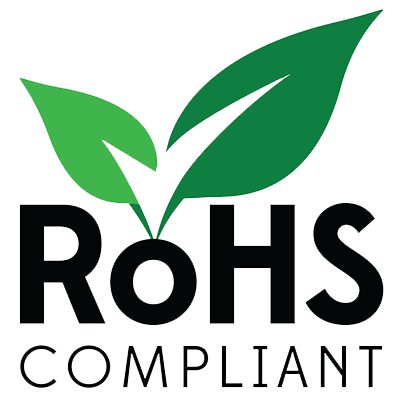
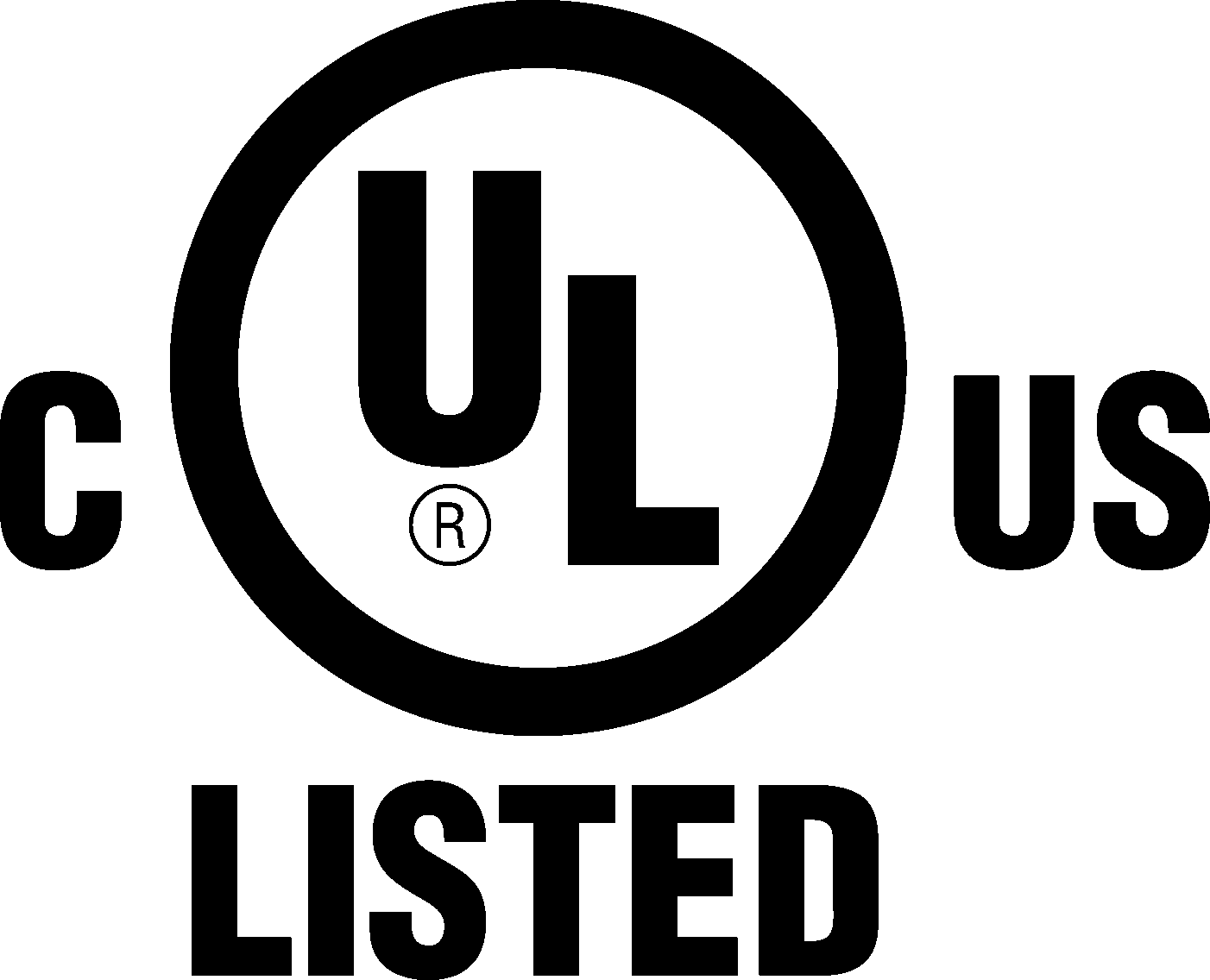
Shipping Technology & Policies
Drop Shipments & Blind Shipments
Drop and Blind Shipments are our specialty, we gladly process these orders for registered users on our website without additional fees. We encourage you to send us your company packing slip, and specify the “Ship From” address and your customer part numbers. Our system integrates with third party shipping APIs like UPS, FedEx, etc. and will ensure that the end user is none the wiser of our involvement in our assistance of fulfillment.
Same Day Shipping on Stock Orders
Our stock availability on our website is constantly updated to display accurate quantities. Once your online order is submitted, our orders team will quickly verify the information and process the order. If the order is placed before 4pm EST, it will be shipped the same day!
Third Party Collect Shipping
To ensure accurate billing for Third Party Shipping Charges, shipping carriers require more that just an account number for this service. Due to this, you may be contacted by a WoCo representative after your order is placed for billing information. In the event the charges are refused by the third party, the shipping charges will be billed to you using the same payment method used for the order.
Shipping Technologies for Accurate Orders
We strive to provide the best experience, including shipping accuracy, to avoid any headaches of mis-shipments. Our entire catalogue is serialized to ensure order accuracy at time of warehouse pick. When processing your order, our system will calculate the estimated package weight to verify item and quantity accuracy.
Dedicated Sales Staff
Need help? Ask the experts!
With over 30 years of experience in the power and data industry, we have the expertise to help you find exactly what you are looking for. We're more than just an online store, we have experts in the power and data industry that can help you online, over the phone, or via email.
-
Have a request from a customer and not sure what you need? Let us quote it for you!
-
Looking for a specific product and can't find it? Let us find it for you!
-
Need a question answered quickly? Live Chat with us!





























